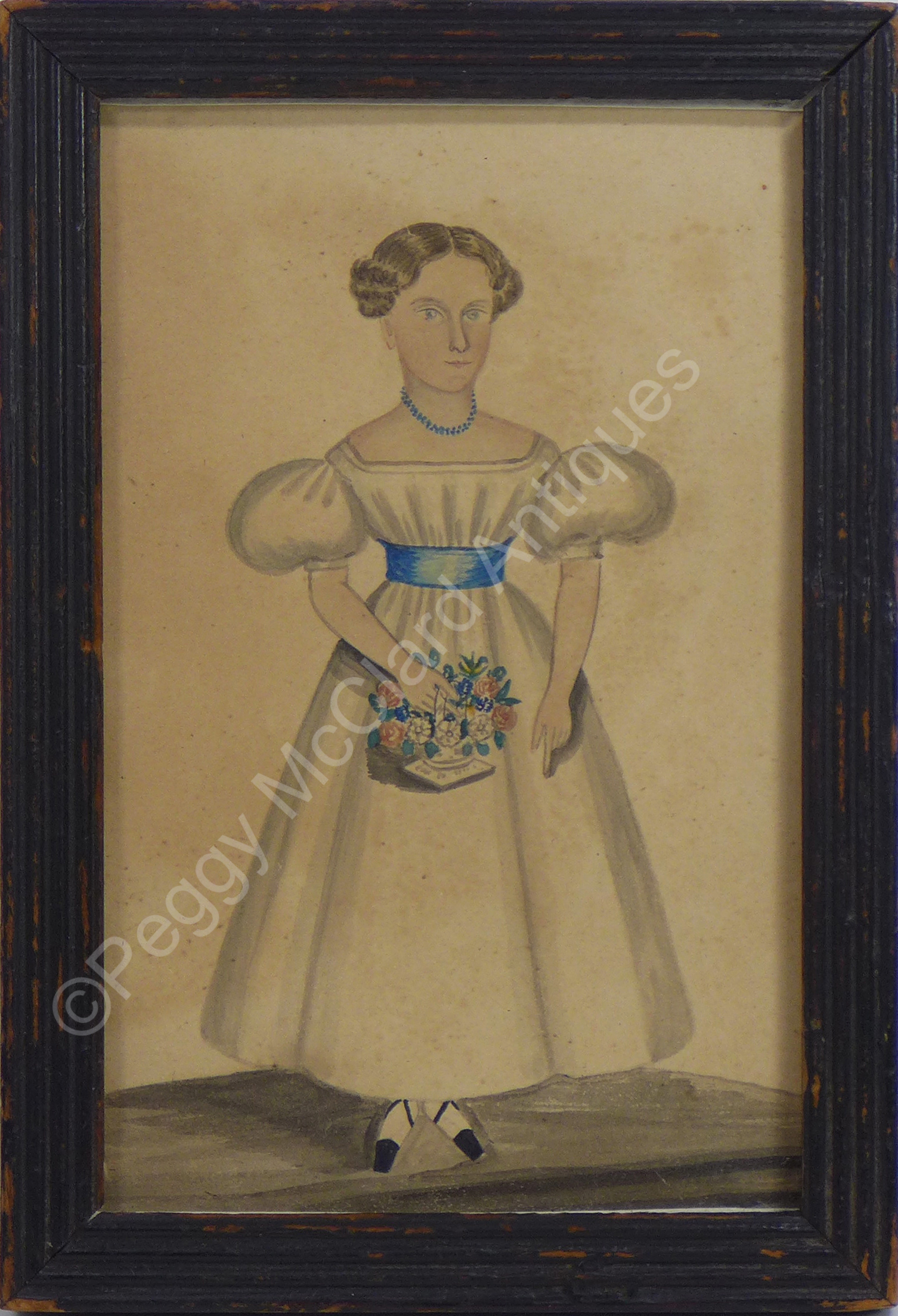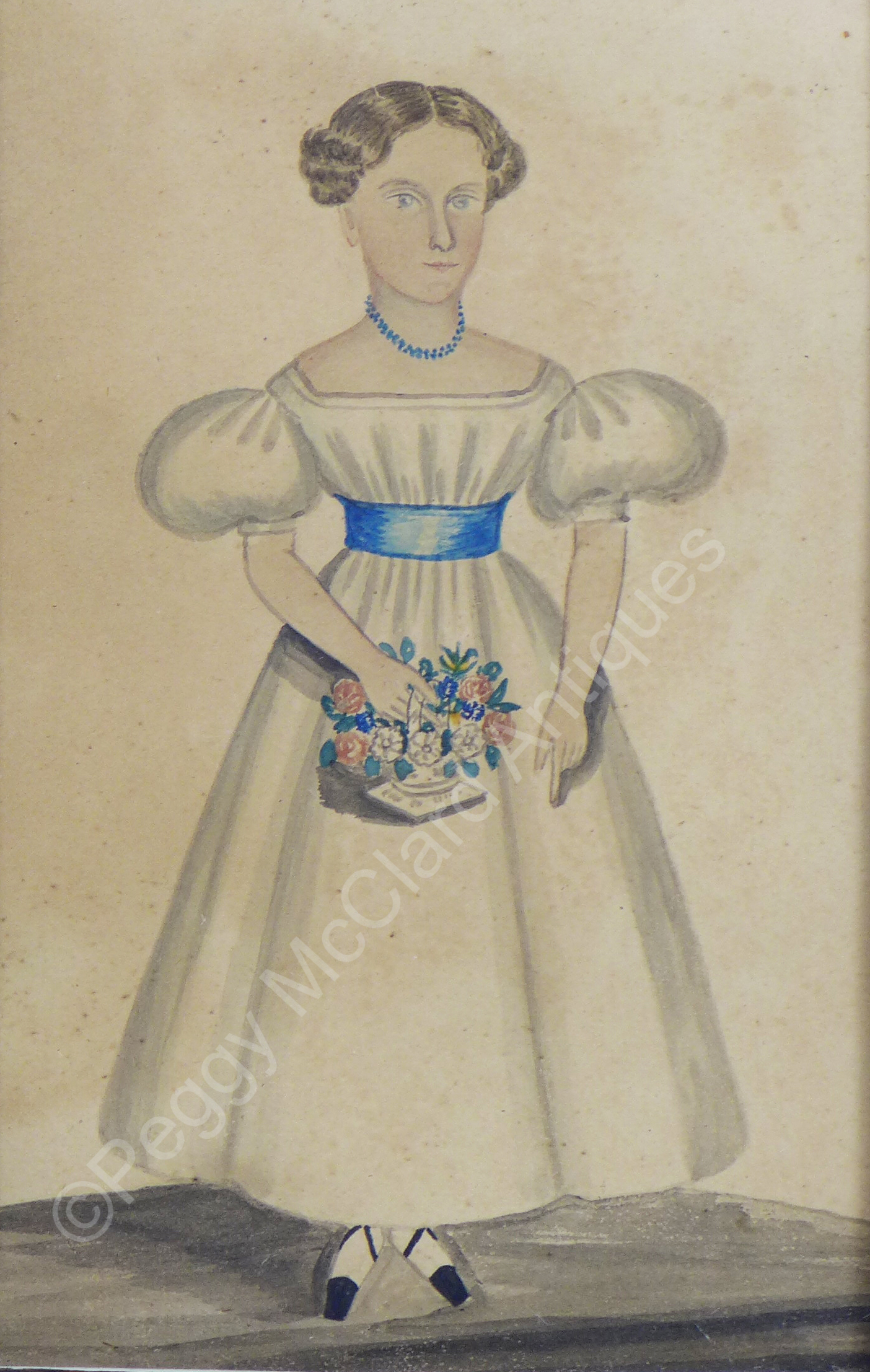
Deborah Goldsmith (1808-1836) was one of the many early 19th century young women who enjoyed drawing and painting but, more importantly to us, she was also one of the very rare women who pursued portrait painting professionally. She was born to Richard and Ruth Minor Goldsmith in North Brookfield, New York but spent much of her adolescence in the more cultured town of Hamilton, NY at the home of her sister and silversmith brother-in-law, Sanford Boon. It appears that Goldsmith had no formal art training but she apparently found and practiced her passion early. Her earliest known commissioned painting is a conversation watercolor portrait depicting Mr. & Mrs. Lyman Day and their daughter Cornelia. Given that Cornelia was born in 1822 and appears to be less than 1 year old in the portrait, it seems that Goldsmith painted this family portrait when the artist was about 15 years old.
While the Day Family portrait is more naïve than later known works, it shows Goldsmith’s early interest in home interiors as it shows the patterned carpet and walls as well as chairs with widely spayed legs. In the very early piece, Goldsmith even placed a newspaper into the hand of Mr. Day. Considering that the Day’s home was in Sangerfield, NY, a good 13 miles from Goldsmith’s sister’s house in Hamilton or more than 10 miles from her parent’s home in North Brookfield, it appears that Goldsmith had hit the itinerant path of a portrait painter even at 15. Her itinerant travels found painting commissions in Brookfield, Hamilton, Lebanon, Toddsville, Hartwick, Cooperstown and Hubbardsville, New York even though she painted professionally only until her marriage to George Addison Throop in 1832. Only a handful of her paintings have been identified. They include watercolor on paper or ivory and oil on panel. Her commissioned work appears to be confined to portraits but Goldsmith put together at least two friendship or commonplace albums, filled with drawings of pictorial scenes based on prints, floral vignettes, portraits and poems. Both of the identified albums are owned and reproduced on microfilm at the Archives of American Art, Washington, D.C.
Goldsmith met George Throop when she was painting portraits of him and other members of the Throop family. After a year of courtship by mail, Deborah married Throop on December 27, 1832. She stopped seeking painting commissions but stayed home although she did continue to paint and save them in her commonplace books. She and Throop had a son and daughter who were left without their mother when Deborah died in 1836, at only 27 years old.
This lovely young full-length girl shows characteristics of Goldsmith later works. Although most of her single portraits were half-length, she certainly could paint full-length as she proved with the two known family conversation pieces. It is marvelous that she chose to depict this young girl full-length down to her slippers with ribbons for tying. Unlike most of her portraits of adult women who Goldsmith depicted in dark colored dresses with long, puffy sleeves and carves or fichus, Goldsmith shows this young girl’s youth and innocence with white dress with a low, squared neckline, short puffed sleeves and bright blue sash. The blue of the sash and necklace grab the viewer’s eye and draws it first to the sash and basket of flowers in the girl’s hand and then up to her face. It is a lovely visual statement. Although Goldsmith’s painting improved from her early painting of the Day Family, her main naïve characteristics remained in her style. The eyes in this young girl are almond-shaped and the nose a bit flat. Her lips are tight and somewhat pursed. Goldsmith’s work shows a fondness for using the color blue, both as a wash to shade and contour hands and faces (used to a lesser extent in this painting) but also as to draw the eye into the painting as she did here. Almost all of Goldsmith’s sitters have something in both hands or in the one hand that is depicted. This covered her weakness in drawing hands. Here we see both of the young girl’s hands. In the empty hand, her fingers curl so that her extended index finger seems to point to the ground.
This is a wonderful folk portrait by a greatly sought-after, rarely found artist. It depicts naïveté and elegant simplicity from a self-trained artist with a real artist’s eye. The portrait is in lovely condition with very light even toning and a light scattered staining. Nothing that is very noticeable. She resides in a period black frame with a reeded profile that measures 4 ½” x 6 ½”. She is conservation mounted and from the renowned folk art collection of Ralph & Suzanne Katz. Circa 1831.
#5885 $3200
References:
Brant, Sandra & Cullman, Elissa, Small Folk: A Celebration of Childhood in America, E.P. Dutton, New York in association with the Museum of American Folk Art, 1980. Plate 23 at 21.
D'Ambrosio, Paul S. and Emans, Charlotte M., Folk Art's Many Faces: Portraits in the New York State Historical Association, New York State Historical Ass'n, Cooperstown 1987. 86-90.
Hollander, Stacy C., American Radiance: The Ralph Esmerian Gift to the American Folk Art Museum, American Folk Art Museum, New York in association with Harry N. Abrams, Inc., Publisher, 2001. 384-85 & plate 17 at 46.
Rumsford, Beatrix, American Folk Portraits Paintings and Drawings from the Abby Aldrich Rockefeller Folk Art Center, Boston: Little Brown, in association with Colonial Williamsburg Foundation (1981). 108-10.
Smithsonian Archives of American Art, https://www.aaa.si.edu/collections/deborah-goldsmith-commonplace-books-8977.

